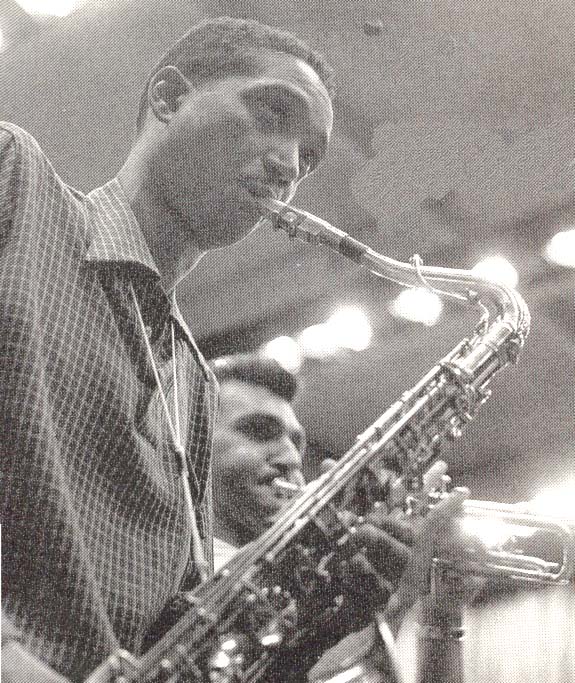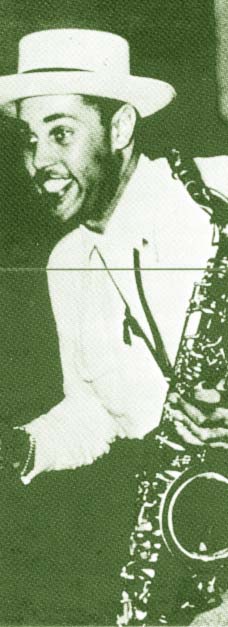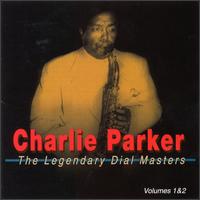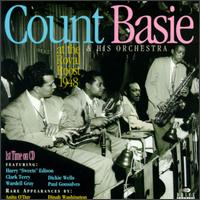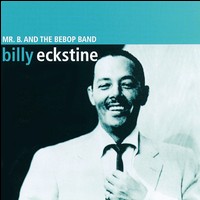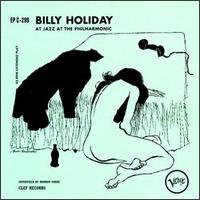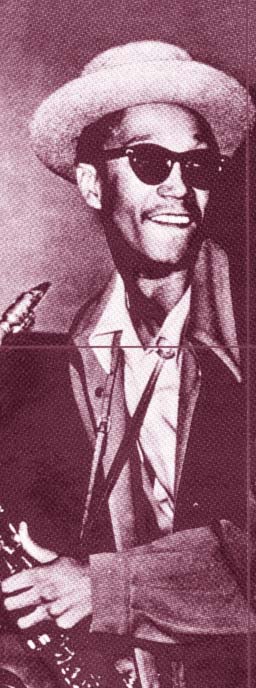|
In one of the great novels of the 20th Century, 'Ti Jean' took the time to include our hero, Wardell.
On Stage
LT Dexter chasing Wardell, 1947
With Bird on Dial
On CD with the Count...
...with Billy Eckstine (above),
and a Jazz at the Philharmonic date with Billie Holiday.
Bill Moody's 'Death of a Tenor Man', a jazz mystery based on the life and death of Wardell Gray. Moody has also written a similar book focusing on Clifford Brown.
|
<<<Wardell Gray
(Continued) Cut's like 'One For Prez' (like Bird's 'Ornithology' a contrafact of 'How High The Moon') feature speedy, fluid interplay between Gray and Marmarosa. 'Easy Swing' which was lifted by Bird for 'The Steeplechase', and then reclaimed by Gray and Dexter Gordon in 1952, is taken at an easy tempo, and illustrates why Gray is thought of by many mainly as a transitional figure between swing and Bop (only partially true). In February 1947, Gray made the first of his legendary Dial recordings as a member of the Charlie Parker Septet. Alongside old pals Marmarosa, Callender and McGhee and with Barney Kessel on guitar and Don Lamond on drums the septet was under the leadership of the newly clean Bird. Parker took the occasion to commemorate his recuperation as ward of the state with the classic 'Relaxing at Camarillo'. All of the players are in rare form. Commencing with a unison chorus, Bird comes on with a relaxed but assured solo, followed immediately by Gray, McGhee and Kessel. 'Cheers', 'Carvin' The Bird' and 'Stupendous', all recorded at that session, are classics in the mighty Parker canon, and proof that West Coast jazz was not all cool. It was around that time that Gray and Dexter Gordon began to be paired in tenor sax duels at clubs like the Dunbar and The Bird In The Basket, at the heart of LA's Central Avenue jazz scene. Central Avenue had been the entertainment center of Los Angeles' burgeoning Black community since the 20's. All of the great Black dignitaries of the day (and many of their white counterparts) could be found at clubs like Dink Johnson's Rib House, The Club Alabam and Shepp's Playhouse digging local jazz and R&B talent and all of the great national bands. Jack Kerouac described it in 'On The Road': 'Terry came and led me by the hand to Central Avenue, which is the colored main drag of LA. And what a wild place it is, with chickenshacks barely big enough to house a jukebox, and the jukebox blowing nothing but blues, bop and jump…..The wild humming night of Central Avenue - the night of Hamp's "Central Avenue Breakdown" - howled and boomed along outside."It was in this heated atmosphere, in the spring of 1947 that Gordon and Gray began to meet on stage and engage in hours long showdowns, riff mounting on riff, chorus on chorus. But unlike the famed cutting contests of jazz lore, the point here wasn't for one player to beat the other. The excitement was in the chase. This was never truer that when Gordon and Gray went into the Dial Studio on Thursday June 12, 1947, and recreated some of the heat they generated in the after-hours clubs with the two-sided masterpiece named coincidentally enough 'The Chase'. The main theme is stated in unison, then Dexter takes the first solo, and Wardell the second. After Jimmy Bunn solos on piano, the two tenors trade solo segments, starting with 16 bars, moving down to 8 bars, and closing in on each other at 4 bars apiece. As the solos get shorter, the tension increases and the listener gets the feeling that the two tenors are waging an impromptu war of ideas each one picking up where the other left off, feeding on his energy, building on his ideas and creating new sounds. It’s like one of those long algebraic equations you see on a Physics classroom blackboard - –line after line, ever more complicated until the numbers move from the blackboard to the atom bomb and – BANG! – the atom is split and the atmosphere catches fire. 'The Chase' went on for nearly seven minutes, and two sides of a 78. When it was released it rapidly became the best selling record in Dial's short history, even outselling Bird's sides for the label. The following month they would be recorded live, in concert in a much longer performance that would be span several 78's, 'The Hunt'. Again, from 'On The Road': "They ate voraciously as Dean, sandwich in hand, stood bowed and jumping before the big phonograph, listening to a wild bop record I had just bought called 'The Hunt', with Dexter Gordon and Wardell Gray blowing their tops before a screaming audience that gave the record fantastic frenzied volume. The Southern folk looked at one another and shook their heads in awe."Kerouac's colleague John Clellon Holmes also praised this legendary recording: "The Hunt: listen there for the anthem in which we jettisoned the intellectual Dixieland of atheism, rationalism, liberalism - and found our group's rebel streak at last."The pair would reprise their duel 1952, and lightning struck again. The Decca 10" LP of 'The Chase' and 'The Steeplechase' is another very hot live recording, with all of their original fire intact, and several more minutes in the LP format for the flames to rise. The availability of more efficient electronic recording equipment, and the longer LP sides gave the pair the space they needed to be heard, without having to flip six or eight 78 sides. Wardell headed east to the Big Apple in 1949, and recorded in the band co-led by Tadd Dameron and Fats Navarro, alongside fellow tenor man Allen Eager. It was during this time that he would grace the front line of Benny Goodman’s Bop-leaning unit. What resulted was certainly not the most exciting music either man ever slapped on wax, but it’s worth searching out to hear Gray on tunes like ‘Stealing Apples’ - especially playing beside clarinetist Stan Hasselgard - and to see a point in time when Goodman tried to jump onto the bop-wagon, a few years too late. That year he made his next date as a leader, fronting the extra-solid New York City rhythm section of Al Haig (piano), Tommy Potter (bass) and Roy Haynes (drums) on four tracks. The first, ‘Twisted’ has assumed legendary status, as much for Gray’s outstanding original recording, as for the vocalese written to it a few years later by the great Annie Ross - who recorded it first as a solo and then several times more with Dave Lambert and John Hendricks). More people are probably familiar with the retake done 20+ years on by none other than Joni Mitchell (with help from Cheech and Chong). ‘Easy Living’ is a moving ballad performance, given an almost ironic air by Gray and company. ‘Southside’ is a great uptempo bopper with some of Gray’s best playing. CD buyers are advised to grab the Prestige/Original Jazz Classics discs, ‘Wardell Gray Memorial’ Volumes 1 and 2. These discs encompass all of Gray’s studio sessions as a leader between 1949 and 1953, and both feature numerous alternate takes (in the case of the four tunes from the 1949 sessions, 4 takes of ‘Twisted’, 2 of ‘Easy Living’ and 7 takes of ‘Southside’ and 1 of ‘Sweet Lorraine’). While possibly monotonous for the casual listener, those of you that dig Wardell Gray will find them an invaluable window into his creative process, and the best way to get a close look at the nuances in his solos. Between 1948 and 1952 Gray played with the Basie band, playing and recording not only with the full band but with a very interesting sextet led by The Count. Among his features with the Basie band, the famous ‘Little Pony’ (written by Neil Hefti) features some smokin’ solos. Fortunately a good deal of his excellent playing with Basie has been preserved in airchecks. There’s a fantastic disc on Moon Records (Wardell Gray: How High The Moon) which features the Basie Sextet at Birdland in 1950 and 1951. Bopping at high speed on numbers like Denzil Best’s 'Move', swinging on Basie classics like ‘One O'clock Jump’ and ‘Jumping At The Woodside’ and moving into the realm of Chamber Jazz on a beautiful arrangement of ‘How High The Moon’. It seems a shame that this group didn’t make it into the studio. The disc also includes a 1952 jam with Chet Baker (in a different group), but the presence of woefully overmatched second tenor Dave Pell brings things down a notch. ‘Wardell Gray Memorial Vol. 2’ includes an April 25, 1950 Gray-led session recorded on his home turf in Detroit (Bob Weinstock reportedly went to Detroit especially to record Gray who was in town performing at the Bluebird) with Phil Hill (piano), John Richardson (bass) and Woody Herman sideman Art Mardigan (drums). This features four tunes (again in multiple takes), ‘Blue Gray’, ‘Grayhound’, ‘Treadin’ (all three Gray originals) and ‘A Sinner Kissed An Angel’. The takes of ‘Blue Gray’ (especially 1 & 2) feature significantly different solos, and as always Gray is in supremely confident form. ‘Grayhound’ also features significant recasting of the song from version to version, take 2 being the shortest (at 1:07) and the most radically different by far. ‘A Sinner Kissed An Angel’ (an old Frank Sinatra number) is another emotional ballad performance, perhaps the best of its kind in the Gray canon. ‘Treadin’’, a brisk blues in the ‘Now’s The Time’ mold is a real mover. August 27, 1950 found Wardell Gray back in LA, reteamed with his partner Dexter, as well as Clark Terry, and Sonny Criss in a red-hot live jam at the Hula Hut. Both ‘Scrapple From The Apple’ (on which Dexter sits out) and ‘Move’ (which are listed in reverse order on the CD) are amazing. ‘Move’ flies along at a blinding pace (the listener wonders how musicians can play at this pace without expiring on stage), with a highly energized audience voicing their approval throughout. Gray’s solos are nothing less than spellbinding (quoting past triumphs like ‘Twisted’) and Criss illustrates how the all encompassing influence of Bird, in the right hands was a wonderful thing. ‘Scrapple From The Apple’ is a slightly more relaxed, but no less exciting number, showing that though they hadn’t matched axes in two years, Wardell and Dexter didn’t have to go far to find the groove. There is more classic live playing to be heard in a 1951 date with Charlie Parker (available as 'The Happy ‘Bird’ on Collectables Jazz Classics), recorded at Christy’s Restaurant in Boston. Though the sound quality is spotty (what do you want from a 50 year old amateur recording) it's no Dean Benedetti wire recording and the band is excellent. With Bird and Wardell, Walter Bishop (piano), Teddy Kotick (bass), Roy Haynes (drums) and Little Benny Harris (trumpet) the band works out on a short blues (‘Happy Bird Blues’) and two long jams on ‘Scrapple From The Apple’ and ‘I May Be Wrong’. Everyone is in excellent form (even if they do have to take a little time to warm up) and the listeners are treated to the sound of Bird yelling ‘Go, Wardell!’ from the sidelines. Gray made his way back into the studio as a leader in January of 1952. The LA session featured a young Art Farmer (trumpet), an even younger Hampton Hawes (piano) and Larance Marable (drums). The date featured Buddy Collette’s contrafact of ‘I’ll Remember April’, ‘April Skies’, as well as two more Wardell Gray solos that made their way into the world of vocalese via Annie Ross; ‘Farmer’s Market’ and 'Jackie' (by Farmer and Hawes respectively). Gray is once again (as always) in top form. The date, one of the earliest for Art Farmer proved to be a pivotal one in his career. Later that same year (September 9), Gray, Farmer, and Hawes (with Joe Mondragon on bass and Shelly Manne on drums) were recorded at the Haig (the famous home of the Mulligan / Baker quartet). The set (available on a Fresh Sound import) includes two Tadd Dameron tunes (The Squirrel and Lady Bird), Bird’s ‘Donna Lee’, Bernie Miller’s ‘Bernies Tune’ (recorded earlier at the same club by Lee Konitz with the Mulligan/Baker group) and a few standards. The sound quality is fairly good and the playing is excellent. His last studio session in a major role was five months later as a member of Teddy Charles’ West Coasters. Vibist Charles had been leading a number of forward thinking sessions on the Coast with among others Jimmy Giuffre and Shorty Rogers. While this date isn’t quite that far out, it does boast the debuts of Frank Morgan (alto) and the great Sonny Clark (piano). ‘So Long Broadway’ is very cool and in a minor mode, with tasty solos from Morgan, Gray and Charles. ‘Paul’s Cause’ is a lightly swinging number with modernist touches, and a nice solo by Gray. The group recasts ‘The Man I Love’ starting slow and melancholy, but picking up the pace quickly. It features Gray’s best solo of the date. Clark’s 'Lavonne' begins with just the rhythm section, moving into solos by Morgan, Charles and finally Gray. This was to be the last time (not allowing for bootlegged live recordings or work as a sideman) that Wardell Gray would be heard until his death two years later. He had been hired to play in Benny Carter's orchestra for the opening of the first integrated casino/showroom in Las Vegas. By this time he had foregone his early opposition to drugs and gotten lost in smack. There was never a conclusion in regard to the circumstances of his death. He was found, dumped on the outskirts of town, his neck broken. There was some speculation that he may have overdosed in the company of a dancer and broke his neck in a fall. In order to keep the heat off of himself, he supposedly got rid of the body. There have even been those who surmised that Gray may have run afoul of mobsters. Jazz and mystery writer Bill Moody even wrote a fictional account of a modern day investigation into Gray's death, "Death Of A Tenor Man". Either way, the life of Wardell Gray, one of the great, post-war jazz tenor saxophonists, came to an abrupt end in 1955. Though the lack of records between 1953 and 1955 suggest that heroin had stolen much of his thunder, there were many before and after him who emerged from that particular storm, battered but still performing. As it stands, the bulk of his best work, spanning less than fifteen years is available on CD. Some of his recordings with Hines and Eckstine are available on French CD's. The two 'Wardell Gray Memorial' volumes are indispensable and the best gauge of his prowess as a leader. 'One For Pres', his 1946 session is available both on Black Lion (with extra takes) and on a UK CD, 'The Bebop Masters'. The original version of 'The Chase' has been available on several CD reissues, including a Stash collection of Dexter Gordon's Dial recordings. The 1952 LP of 'The Chase and The Steeplechase' (click on the link to see some pix) has yet to see CD reissue. I found my original copy of the LP at a record store run by an overaged heavy metal/swinger type, who ran to his record guide for a price and then charged me less that $20 for what has proven to be a pretty rare platter. 'The Hunt' is available on a Savoy Reissue called 'Jazz Concert West Coast'. As far as Gray's work as a sideman, his sides with Dameron and Navarro are available on a Blue Note collection, and his work with the Benny Goodman band was on CD but is currently out of print (aside from selected compilation cuts). His work with Basie is harder to track down. I had to grab the studio sides on a French LP reissue. Unfortunately Count Basie, one of the greatest bandleaders in all of jazz, is poorly represented in the CD racks. You can get a copy of 'Basie's Beatles Bag', but if it's his more progressive work from the late 40's/early 50's, you're out of luck. The aforementioned Moon CD is definitely worth looking for, and I've seen it listed with some internet retailers. All of his studio recordings with Bird are available on the first disc of the Dial Masters set. Their live set may be harder to track down. The live set from the Haig on Fresh Sound, is like many discs from the Spanish label, fairly easy to come by (assuming you have access to a music store with a fairly decent jazz selection). |

